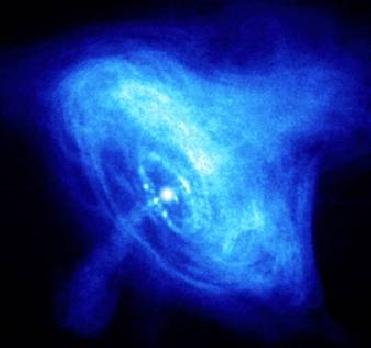
Neutron stars are compact objects that are created in the cores of massive stars during supernova explosions. The core of the star collapses, and crushes together every proton with a corresponding electron turning each electron-proton pair into a neutron. The neutrons, however, can often stop the collapse and remain as a neutron star.
Neutron stars are fascinating objects because they are the densest objects known. They are only about 10 miles in diameter, yet they are more massive than the Sun.
One sugar cube of neutron star material weighs about 100 million tons, which is about as much as a mountain. Like their less massive counterparts, white dwarfs, the heavier a neutron star gets the smaller it gets.
Neutron stars can be observed occasionally, as with Puppis, as an extremely small and hot star within a supernova remnant. However, they are more likely to be seen when they are a pulsar or part of an X-ray binary.
A neutron star is typically only about 20 km (12.5 miles) across, yet within this small region may be over 2 solar masses of material. The result is a gravitational field at the surface of a neutron star about 70 billion times stronger than that on Earth. Neutron stars have a density of about 1014 g/cm3, or roughly a million times that of white dwarfs.
In structure, a neutron star more closely resembles a solid, miniature planet than it does an ordinary star. Its core consists mainly of densely-packed neutrons, with a sprinkling of protons and an equal number of electrons, in a liquid-like state known as neutronium. Surrounding this is a mantle topped by a crust, perhaps 1 km thick, consisting of a stiff lattice of nuclei of the same elements as found on Earth through which flows a sea of electrons.
Neutron stars may appear in supernova remnants, as isolated objects, or in binary systems. Four known neutron stars are thought to have planets. When a neutron star is in a binary system, astronomers are able to measure its mass. From a number of such binaries seen with radio or X-ray telescopes, neutron star masses has been found to be about 1.4 times the mass of the Sun. For binary systems containing an unknown object, this information helps distinguish whether the object is a neutron star or a black hole, since black holes are more massive than neutron stars.
Some known neutron stars:
•PSR J0108-1431 - Closest neutron star
•LGM-1 - The first recognized radio-pulsar
•PSR B1257+12 - The first neutron star discovered with planets (a millisecond pulsar)
•SWIFT J1756.9-2508 - A millesecond pulsar with a stellar-type companion with planetary range mass.
•PSR B1509 - 58 source of the "Hand of God" photo shot by the Chandra X-ray Observatory
- Courtsey:
NASA
 Previous Article
Previous Article Next Article
Next Article













The Indian Air Force, in its flight trials evaluation report submitted before the Defence Ministry l..
view articleAn insight into the Medium Multi-Role Combat Aircraft competition...
view articleSky enthusiasts can now spot the International Space Station (ISS) commanded by Indian-American astr..
view article